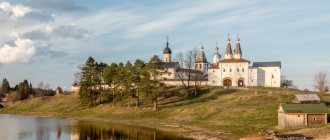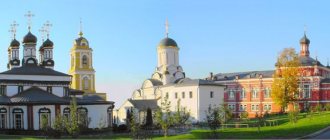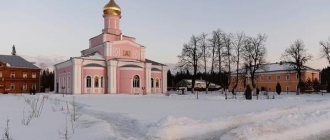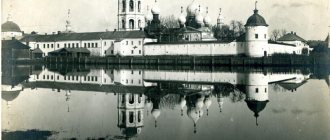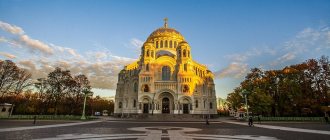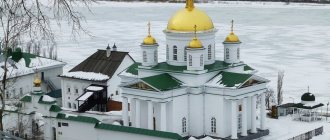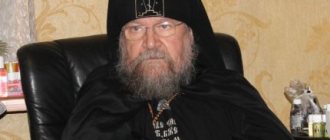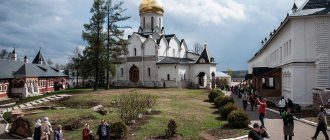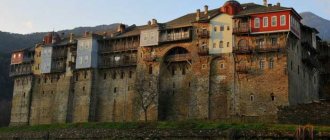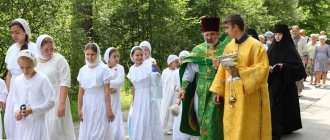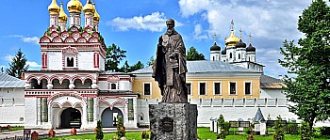The Mother of God Nativity Monastery is one of the oldest in Russia; it was founded at the end of the 12th century. For 150 years, before the founding of the Trinity-Sergius Lavra, the monastery was the main spiritual center throughout North-Eastern Rus'. Currently, the Mother of God Nativity Monastery is active; it is located in the center of the city, on a hill above the bed of the Klyazma River.
Even if you don’t have much time during your trip and you only see the main sights of Vladimir, it is undoubtedly worth visiting this ancient monastery. The architectural ensemble consists mainly of buildings from the 17th–18th centuries, including the monks’ cells and the archimandrite’s chambers, the Church of the Nativity (a massive elongated building) and the Holy Gate, the Cathedral of the Nativity of the Virgin Mary and other historical buildings. The Vladimir Theological Seminary is located on the territory of the monastery.
You will be able to attend a service and listen to the ringing of bells, as well as feel the spirit of antiquity and history of the Russian state. To make it easier for guests to navigate, there is a plan of the monastery at the entrance, and nameplates are placed on all important objects.
Formation of the Mother of God Nativity Monastery in Vladimir
The founding date of the monastery is considered to be August 21, 1191, on this day the son of Yuri Dolgoruky, Prince Vsevolod III the Big Nest (he received this name because he had 12 children), laid the foundation for the white stone Cathedral of the Nativity of the Virgin.
The time of formation of the monastery is closely connected with the name of Vsevolod III. The prince patronized the monastery - he assigned considerable lands to it, and appointed the bishops of Vladimir as abbots.
A striking event in monastic life was the burial in the crypt of the Nativity Cathedral in 1263 of Grand Duke Alexander Nevsky. Subsequently, each of the ruling princes, wishing to honor the memory of the great commander, presented gifts to the Mother of God Nativity Monastery and contributed to its development. This was the time when the monastery strengthened and prospered.
True, during this period there were also dark pages in its history. In 1238, during the invasion of hordes of the Tatar-Mongol yoke, the monastery buildings were looted and set on fire, and the monks and abbot were killed. It took a lot of effort and time to restore monastic life again.
Story
In 1191, Grand Duke Vsevolod Yuryevich, having chosen a place in Vladimir (in the middle Kremlin city) on the eastern side, in a scree near the Ivanovo Gate, laid the foundation for a monastery.
The chronicle indicates the time of foundation in the summer of 6699 (1191/1192): “in the same summer, Grand Duke Vsevolod founded a stone church in the city of Volodymeri, the Nativity of St. Theotokos of August on the 22nd day under Bishop John.” The Grand Duke himself and his entire court were present at the foundation of the church. At the same time, a hostel was established in the monastery and many villages and lands were granted for maintenance from the Grand Duke. The leadership of the Nativity Monastery was carried out by abbots (until 1230), despite the fact that abbots Simon and Mitrofan, one after the other, were bishops in Vladimir.
Since 1230, the monastery began to be governed by archimandrites. The Nativity monastery began to be called the great archimandry and until the time of Tsar Ivan Vasilyevich it was listed as the first among Russian monasteries. From the half of the 13th to the beginning of the 14th century, the All-Russian metropolitans, who transferred the primatial see from Kyiv to Vladimir, had a stay in the Nativity Monastery, which was considered their cathedral.
Monastery in the XIII-XIV centuries
In 1214, Yuri Vsevolodovich elected the Nativity abbot Simon as bishop of Suzdal. On March 14, 1227, in place of Simon, by the election of the same prince, Abbot Mitrofan was consecrated bishop of Suzdal by Metropolitan Kirill, who was then in Vladimir.
In 1230, by the election of the nephews of Yuri Vsevolodovich Rozhdestvensky, the first Archimandrite Kirill was consecrated Bishop of Rostov.
In 1237, during Batu’s invasion of Vladimir, the abbot of the monastery, Archimandrite Pachomius, was killed by the Tatars, and with him the entire brethren of the monastery were beaten, and the monastery itself was plundered and devastated.
On November 23, 1263, Grand Duke Alexander Yaroslavich Nevsky, who died on November 14 in Gorodets, on the way back from the Horde, was buried in the church of the Nativity Monastery. When the Grand Duke's throne was transferred from Vladimir to Moscow, the Grand Dukes, out of respect for their ancestor Prince Alexander Nevsky, made significant contributions to the Nativity Monastery. So John Danilovich Kalita wrote in his spiritual will in 1328: “I bought what I have of a village on Kirzhach near Prokopye from the abbot, another Leontyevskoye, a third Sharapovskoye, and I give that to St. Alexander in remembrance"; John Ioannovich wrote in his spiritual 1356: “I gave the village of Pavlovskoe to St. Alexander for the benefit of his memory"; his son Dmitry Ioannovich in the first spiritual year of 1371 confirms: “but that my father, the great prince, gave the village of Pavlovskoe to Saint Alexander cannot be moved.” In his spiritual letter of 1379 it is said: “and from my silver vessels they will give a great silver dish with a ring to the Holy Mother of God in Volodymyr.”
In 1388, the Nativity Archimandrite Pavel was consecrated by Metropolitan Pimen as Bishop of Kolomna in place of Bishop Gerasim.
Monastery in the 16th century
In 1517, by conciliar election and the permission of the Grand Duke, Archimandrite Gennady was installed as Bishop of Suzdal.
In 1566, Archimandrite Joachim participated in the council in Moscow and was the guarantor of Prince Mikhail Ivanovich Vorotynsky, and was also at the council in 1580 on the non-confiscation of estates from monasteries and the non-purchase of new ones from the peasants.
In 1584, Archimandrite Herman attended a council on the abandonment of estates at monasteries.
In 1598, Archimandrite Varlaam was in Moscow at the cathedral and signed the letter of election of Boris Feodorovich Godunov to the kingdom.
Monastery in the 17th century
Modern musicologists consider Archimandrite Isaiah (in the world Ivan Timofeevich Lukoshko) one of the greatest masters of znamenny singing, a representative of her “Usolsk” school. In 1613, the archimandrite was at the election of Mikhail Fedorovich to the kingdom and signed the electoral document first after the bishops. In 1605, Archimandrite Isaiah became the confessor of False Dmitry I. On June 22, 1619, he was at the installation of Metropolitan Philaret of Rostov on the patriarchal throne. And on September 28, 1645, Archimandrite Jonah was present at the crowning of Alexei Mikhailovich.
In 1667, the Greek patriarchs, Paisius of Alexandria and Macarius of Antioch, who were traveling to the Great Moscow Cathedral, while they were in Vladimir and respecting its antiquity and celebrity, upon arrival in Moscow, with the permission of Tsar Alexei Mikhailovich and on the advice of Patriarch Joasaph, granted the Archimandrite of the Nativity Monastery Philaret the right to wear tablets on the mantle and use the bishop’s staff in service, for which they were given a certificate; from that time on, Archimandrite Philaret began to be called the most reverend. In the same year, Filaret was at the Moscow Council on the correction of books and on various church rites, and on November 30 of this year he received the order to present a letter to Patriarch Nikon about his arrival from the Resurrection Monastery in Moscow, and on December 1 he was among the council members at the deposition of Nikon.
In 1672, Archimandrite Vincent corrected the life of St. Alexander Nevsky, compiled by order of the Tsar and Grand Duke John Vasilyevich by Hieromonk Mikhail.
Monastery in the 18th-19th centuries
On July 14, 1723, Archimandrite Sergius received the Highest Decree of Emperor Peter I to transfer the relics of St. Petersburg to St. Petersburg. Prince Alexander Nevsky, located openly since 1381, in the Church of the Nativity of the Blessed Virgin Mary. The last archimandrites of the Nativity Monastery, Pavel and Platon Petrunkevich, were members of the Holy Synod.
Back in 1561, by the will of Tsar John Vasilyevich and by the letter of the All-Russian Metropolitan Macarius, primacy was given to the Trinity-Sergius Monastery and Vladimir-Rozhdestvensky was placed second, and after the establishment of the Alexander Nevsky Monastery from 1720 it was customary to consider it the third, but this monastery due to its antiquity and the advantages that were given to its abbots, it was always under the direct jurisdiction of the All-Russian metropolitans, then the patriarchs, and finally, depending on the Holy Synod, among the stauropegial ones.
At the beginning of the 18th century, as can be seen from the census books of the city of Vladimir, compiled in 1715 by Landrat Prince Artemy Ukhtomsky, there were 64 monastics in the Nativity Monastery, including two archimandrites, six hieromonks and five hierodeacons. From the surviving census book of the same time, according to the census of Chief Inspector Semyon Nikiforovich Korovin, Chief Commandant Andrei Fedorovich Borkov and Commandant Andrei Mikhailovich Veshnyakov, “Volodimer Posad Posad and Yamsky and all ranks of city residents”, it is clear that the Nativity Monastery servants had 96 households on the monastery land in the settlement of Makarovka near the settlement, there are 13 households and 5 households of servants of the Spassky Zlatovrat Monastery attached to the Nativity Monastery.
New Cathedral of the Nativity of the Virgin Mary
On July 16, 1744, by decree of Empress Elizabeth Petrovna, it was decided to establish the Vladimir diocese from the synodal region and turn the stauropegial Nativity Monastery into a bishop's house for the then newly appointed Bishop Platon in Vladimir, since until now the bishops had their residence in the city of Suzdal. Before the establishment of states in 1764, the monastery had 7899 peasant souls and the bishop's house itself was supported by its income. In 1789, upon the union of the Vladimir diocese with Suzdal, Bishop Victor moved to stay in Suzdal, and the Vladimir bishop's house entered the civil department and Governor-General Zaborovsky was located there. In 1797, Bishop Victor, reporting to the Holy Synod that the Vladimir Bishops' House, after the departure of the Governor-General from it, remained idle, presented his opinion on the transfer here of the second-class Tsar Constantine Monastery - but in 1798, before the trip of Emperor Paul I to Kazan, a decree was issued from the Holy Synod regarding the presence of the Right Reverend in Vladimir, and Bishop Victor moved from Suzdal, occupying the Nativity Monastery in Vladimir. From that time on, the Vladimir bishops had a permanent residence in the monastery.
The Nativity Monastery, where the episcopal see was located, near the cathedral stands in a most beautiful, high place, on the banks of the Klyazma River; The hall in it is most charming, along the avenue. However, the buildings in that monastery are few and the circumference is not large; The stone fence is small and we didn’t notice the tower. We were surprised that the monastery was one of the first, and there were few buildings in it.
— Plato (Levshin), 1792
On August 24, 1858, Emperor Alexander Nikolaevich inspected the ancient Church of the Nativity of the Blessed Virgin Mary in the monastery and ordered its restoration. In 1869, the architect-restorer N.A. Artleben, together with D. Koritsky, ordered the demolition of the pre-Mongol temple and, under the guise of restoration, they built a new one in its place.
Tragedy of the 20th century
In the period from 1918 to 1991, departments of the Cheka (OGPU, NKVD, KGB) and pre-trial detention center buildings were located on the territory of the monastery.
Under Stalin, executions and burials of repressed people were carried out on the territory of the former monastery (1930-1950s).
The meaning of the monastery
The high status of the monastery remained until the reign of Ivan the Terrible, the first Tsar of Rus'. By his decision in 1561, the Trinity-Sergius Lavra was recognized as the main center of monastic life. The Mother of God Nativity Monastery of Vladimir became second in importance. 150 years later, under Peter the Great in 1710, the Alexander Nevsky Monastery was founded (since 1797 it became the Lavra). It was here that in 1723 the relics of Grand Duke Alexander Nevsky were transferred and the Vladimir monastery became the third in importance.
Despite the fact that the significance of the monastery as a center of spiritual life declined, until the Bolshevik revolution of 1917 it remained an important center of pilgrimage and a holy, revered place.
Mother of God Nativity Monastery in Soviet times
During its history, the Mother of God Nativity Monastery suffered many times from fires, was restored and rebuilt. But the most terrible days came under Soviet rule, when the territory of the monastery was occupied by various punitive organizations, from the GubChK (provincial emergency commission for combating counter-revolution and sabotage) to the KGB. During the period of Stalinist repressions, mass executions of those repressed, accused of espionage and recognized as enemies of the people took place here.
In memory of those killed, a memorial white stone cross was erected in the monastery garden, and on the monastery wall you will see a memorial plaque with the names of those killed.
Summer morning in the monastery
On a sunny June morning, the monastery is very beautiful. Temples, crosses sparkling in the sun against the blue sky, beautiful roses, peonies, irises and other flowers in the monastery flower beds - all this reminds of the Creator of everything and encourages prayer.
The holy righteous John of Kronstadt writes about the importance of the morning time for prayer: “Catch the morning hours, these are the hours of a new life, renewed by temporary sleep. They point us to the state when we rise renewed on the common morning of the non-evening day of resurrection or when we are separated from this mortal body...”
In our morning prayers, we ask the Lord for blessings on the coming day. And every deed during the day that begins with prayer bears fruit. Thus, with a good, humble disposition of the person praying, prayer becomes the basis of all good things in our life.
“A sinner should not give up prayer because of his sins, for if you think that now you are not worthy to approach God with prayer, then when will you be worthy? When will this dignity come? When will you sanctify yourself, justify yourself and by what? Where does our holiness and truth come from? Christ will justify. Who is righteous before God? “All have sinned and fall short of the glory of God” (Rom. 3:23). Who was Manasseh? Great sinner. Well, is the one who prays rejected? No, he prayed with humility and received mercy.
Who is the woman who wept at the feet of Christ? Harlot, sinner. Has she been rejected by Christ? No. I heard a sweet voice: “Her many sins are forgiven... your faith has saved you, go in peace” (Luke 7:47,50). Your unworthiness cannot harm you in any way. The only thing required is that you abandon your whims and resort with repentance to the Heavenly Father,” argues Saint Tikhon of Zadonsk.
“Pray fervently to the Lord God,” calls on St. Anthony of Optina, “and warm up your cold heart with His sweetest name, since our God is fire. This invocation also destroys unclean dreams. And the heart warms to all His commandments. And therefore, the prayerful invocation of His sweetest name should be the breath of our soul, it should be faster than the beat of our heart.”
“...I can’t wish you anything better than: keep praying, and for this do not expect anything from yourself, from your wisdom and efforts, but everything from the Lord,” writes St. Theophan the Recluse.
May He who gives prayer to those who pray help us all!
June 17, 2021
Quotes are given from sources: https://azbyka.ru/svyatye-otcy-o-molitve
https://svyatye.com/otcy/O-molitve/2.html
Photo gallery:
Share:
Cathedral of the Nativity of the Virgin Mary
Unfortunately, the Cathedral of the Nativity of the Virgin Mary, the main monastery church, built under Vsevolod III, has not been preserved in its original form.
In 1858, Emperor Alexander II, visiting the monastery, drew attention to the dilapidation of the centuries-old structure and ordered funds to be allocated for its restoration. The building was completely dismantled and then restored to its original appearance. The gilded dome of the cathedral looked especially remarkable.
However, in the 30s, when churches were being destroyed everywhere in the USSR, the Cathedral of the Nativity of the Virgin Mary and the bell tower with the clock were also destroyed.
800 years after the founding of the monastery, its revival began. The first service took place on the Feast of the Nativity of the Blessed Virgin Mary in September 1992. At the end of the 19th century, the reconstruction of the Cathedral of the Nativity of the Virgin Mary and the belfry began. Moreover, the architects did not strive to make a copy of the 12th century cathedral; they built a white stone temple in the image of the Vladimir-Suzdal white stone architecture of that time. In 2004, the restored cathedral was consecrated.
